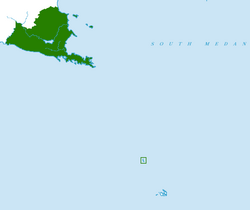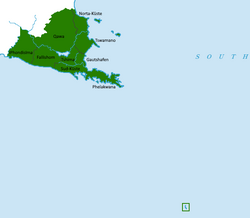Borvastaat
This article is incomplete because it is pending further input from participants, or it is a work-in-progress by one author. Please comment on this article's talk page to share your input, comments and questions. Note: To contribute to this article, you may need to seek help from the author(s) of this page. |
Republic of Borvastaat 4 official languages
| |||||||||
|---|---|---|---|---|---|---|---|---|---|
| Anthem: National Anthem of Borvastaat
| |||||||||
 Location of Borvastaat in Hylasia | |||||||||
 Subdivisional map of Borvastaat | |||||||||
| Capital | Gautshafen | ||||||||
| Largest city | Tshimberg | ||||||||
| Official languages | Borvazunge Ruthish Seloleme Ulwimi | ||||||||
| Recognised regional languages | Sebua !qáxa Fallish | ||||||||
| Ethnic groups (2022) | 26.7% Batho 21.2% Bachaba 17.6% Ixolo 15.8% Ruthish 6.7% Fallish 5.8% Mixed/Colored 3.3% tǃʼàu 2.3% Yinese/Abarian 0.8% Other | ||||||||
| Religion (2022) | 74.3% Gregorianism 13.4% No religion 9.1% Folk religion 2.2% Himayan 1% Other | ||||||||
| Demonym(s) | Borvazi Borvastaater | ||||||||
| Government | Unitary Combinationalist Parliamentary republic with an Executive presidency | ||||||||
| Kagiso Motsepe | |||||||||
• Speaker | Mpho Molefe | ||||||||
| Naledi Sepogodi | |||||||||
| Legislature | National Assembly | ||||||||
| History | |||||||||
| c. 400-2,000BCE | |||||||||
| c. 900-1300CE | |||||||||
| c. 1630CE | |||||||||
| 1 November 1864 | |||||||||
| 18 October 1944 | |||||||||
| 15 April 1984 | |||||||||
| Area | |||||||||
• Total | 853,285.7 km2 (329,455.5 sq mi) | ||||||||
• Water (%) | 1.01 | ||||||||
| Population | |||||||||
• 2022 estimate | |||||||||
• Density | 60.43/km2 (156.5/sq mi) | ||||||||
| GDP (PPP) | 2022 estimate | ||||||||
• Total | |||||||||
• Per capita | |||||||||
| GDP (nominal) | 2022 estimate | ||||||||
• Total | |||||||||
• Per capita | |||||||||
| Gini (2022) | high | ||||||||
| HDI (2022) | high | ||||||||
| Currency | Gauta (Ǥ, BSG) | ||||||||
| Time zone | UTC-1 (Borva Standard Time, BST) | ||||||||
| Date format | dd-mm-yyyy | ||||||||
| Driving side | right | ||||||||
| Calling code | +144 | ||||||||
| Internet TLD | .bs | ||||||||
Borvastaat, officially the Republic of Borvastaat[a], is a sovereign state and the southernmost country in Hylasia. Its nine provinces are bounded to the south by the Galanaic Ocean and to the east by the South Medan Ocean; to the north the nations of X, X, and X. It is the southernmost country on the mainland of the Old World and the second-most populous country located entirely south of the equator, after Nadauro. With a population of over 51 million people, it is currently the 9th most populous nation on Teleon and covers an area of 853,285.7 square kilometres (329,455.5 square miles). Its capital city is Gautshafen while the largest city is Tshimberg.
About 70% of the population are Black Borvastaaters. The remaining population consists of Hylasia's largest communities of Calesian (White Borvastaaters), Abarian (Yinese Borvastaaters), and multiracial (Coloured/Mixed Borvastaaters) ancestry. Borvastaat is a multi-ethnic society encompassing a wide variety of cultures, languages, and religions. Its pluralistic makeup is reflected in the Constitution's recognition of 4 official languages with 3 official recognized minority languages. According to the 2022 census, the two most spoken first languages are Seloleme (24%), spoken as a first language by nearly a quarter of the country's population, and Borvazunge (16.0%), the latter being of Calesian origin. Other Calesian languages spoken in the country are Ruthish (13.6%) and Fallish (7.6%), reflecting the influence of colonialism on the country.
Regular elections have been held in the country for four decades now, though the settler population carried out its own elections for another four decades prior to that. The vast majority of Black Borvastaaters were not enfranchised until 1984. During the 20th century, the black majority sought to claim more rights from the dominant white minority, which played a large role in the country's recent history and politics. The now defunct People's Party imposed apartheid in 1945, institutionalizing previous racial segregation only a year after the country was given independence from the Transmedan Powers in the aftermath of the Great War. After a mixture of guerrilla warfare and non-violent struggles by the Borvastaat National Party and other anti-apartheid activists both inside and outside the country, the repeal of the apartheid legal framework began in 1981 and ended in 1984. Since 1984, all ethnic and linguistic groups have held political representation in the country's liberal democracy, which comprises a parliamentary republic and nine provinces. Borvastaat is often referred to as the "rainbow nation" to describe the country's multicultural diversity, especially in the wake of apartheid.
Borvastaat is a middle power in international affairs; it maintains significant regional influence and is a member of the Non-Aligned Movement, the United Congress, the Hylasian Union, and various regional organizations. It is a developing country, ranking 11th on the Human Development Index, among the highest on the continent. Borvastaat is also one of the few Hylasian nations to have legalized same-sex marriage. It has also been classified as a newly industrialized country and has the largest and most industrialized, technologically advanced economy in Hylasia. Since the end of apartheid, government accountability and quality of life have substantially improved. However, crime, poverty, and inequality remain widespread, with about 40% of the total population being unemployed as of 2021, while some 60% of the population lived below the poverty line and a quarter lived below $2.15 a day.
History
Pre-History
Borvastaat contains some of the oldest archaeological and human-fossil sites in the world. Archaeologists have recovered extensive fossil remains from a series of caves in Qawa Province. These finds suggest that various hominid species existed in Borvastaat from about three million years ago, starting with Australopithecus hominids. Modern humans have inhabited Southern Hylasia for at least 170,000 years. Various researchers have located pebble tools within the Umlambo River valley.
uMzantsi Migrations
Calesian Exploration
Ruthish Colonization
Independence and Apartheid
Post-Apartheid
Geography
Government and Politics
Economy
Demographics
Culture
Notes
- a.^ Borvazunge: Rephublik Borvastaat; Ruthish: Republik Borvastaat; Seloleme: Rephaboliki X; Ulwimi: iRiphabhlikhi X


